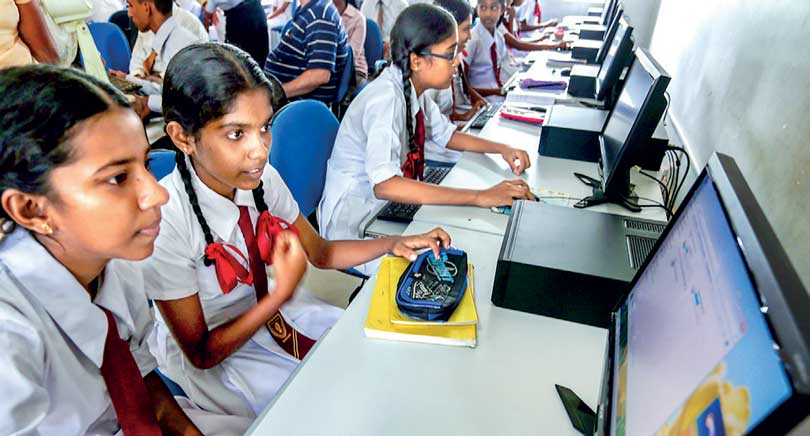Tuesday Dec 09, 2025
Tuesday Dec 09, 2025
Tuesday, 23 July 2024 00:06 - - {{hitsCtrl.values.hits}}

Updating the curriculum to include digital literacy as a core component is vital
 The integration of digital technologies into education is no longer a luxury but a necessity for modern educational systems. This is particularly true for developing countries, where the potential for digital tools to bridge gaps in access and quality is immense. By strategically adopting these technologies, developing nations can revolutionise their educational landscapes, making learning more accessible, engaging, and effective. Here, we outline key recommendations to guide this transformation.
The integration of digital technologies into education is no longer a luxury but a necessity for modern educational systems. This is particularly true for developing countries, where the potential for digital tools to bridge gaps in access and quality is immense. By strategically adopting these technologies, developing nations can revolutionise their educational landscapes, making learning more accessible, engaging, and effective. Here, we outline key recommendations to guide this transformation.
Invest in infrastructure
A foundational step for integrating digital technologies is investing in robust infrastructure. Reliable internet connectivity and the provision of essential hardware, such as computers, tablets, and smartboards, are critical. In many rural and underserved areas, the lack of such infrastructure remains a significant barrier. Governments and international organisations must prioritise funding and initiatives to build this infrastructure, ensuring that all students, regardless of their location, have access to digital learning tools.
In Sri Lanka, the Government has made strides in improving digital infrastructure through the “Smart Classroom” initiative, which aims to equip schools with digital devices and internet access. This initiative has already benefited numerous schools, especially in rural areas, by providing the necessary technology to support digital learning.
Affordable access
Affordability is another critical issue. Programs that make digital devices and internet access affordable for students and educators can help bridge the digital divide. Partnerships with private companies and non-profit organisations can subsidise costs, making technology more accessible to low-income families. For instance, initiatives similar to India’s “Digital India” campaign, which aims to enhance digital connectivity and literacy, can serve as a model for other developing nations.
In Sri Lanka, the “E-Thaksalawa” online education platform, launched by the Ministry of Education, provides free access to educational resources, including textbooks, past exam papers, and interactive lessons. This platform helps students from all economic backgrounds access high-quality educational materials without financial barriers.
Teacher training
Effective integration of technology in education depends significantly on the teachers’ ability to use these tools proficiently. Comprehensive professional development programs are essential to train teachers in digital literacy and the effective use of technology in their teaching practices. Continuous support and resources should be provided to ensure that teachers remain updated with the latest technological advancements. Programs like UNESCO’s “ICT Competency Framework for Teachers” offer valuable guidelines for such training initiatives.
Sri Lanka has implemented the “Teacher Training on ICT” program, which aims to enhance the digital skills of educators. This program includes workshops, online courses, and hands-on training sessions, helping teachers incorporate digital tools effectively in their classrooms.
Curriculum development
Updating the curriculum to include digital literacy as a core component is vital. This involves not only teaching basic digital skills but also integrating technology across various subjects to enhance learning. For example, incorporating coding, data analysis, and the use of digital tools in science and mathematics can prepare students for the demands of the digital economy. The curriculum should be designed to be dynamic and adaptable to technological advancements.
Sri Lanka’s education system has started integrating ICT into the national curriculum, ensuring that students from an early age are exposed to essential digital skills. This initiative aims to build a strong foundation in digital literacy, preparing students for future technological challenges.
Localised content
Creating and promoting digital educational content that is culturally relevant and available in local languages ensures that the material is accessible and engaging for all students. Localised content helps in maintaining students’ interest and makes learning more effective. Educational platforms should focus on developing resources that reflect the cultural and linguistic diversity of the regions they serve.
Public-Private Partnerships
Encouraging collaborations between governments, technology companies, and non-profits can leverage expertise, funding, and resources for technology initiatives in education. These partnerships can drive innovation and provide the necessary support for large-scale implementation of digital tools in schools.
Sri Lanka has seen success through partnerships like Ministry of Education and telecommunication communication companies whitelisting the education content which provide schools and students access online content free of internet cost supporting both teachers and students in the digital learning process.
Focus on equity
Designing policies and programs specifically aimed at reducing the digital divide is crucial. Ensuring that marginalised communities, including girls and children with disabilities, have equal access to digital learning opportunities is essential for inclusive education. Programs like UNICEF’s “GIGA initiative,” which aims to connect every school to the internet, highlight the importance of equitable access.
Data security and privacy
Establishing clear guidelines and regulations to protect student data and ensure privacy is imperative. Educating students and teachers about safe practices online is equally important to protect against cyber threats. Developing countries can learn from frameworks like the European Union’s General Data Protection Regulation (GDPR) to create robust data protection policies.
Pilot programs
Implementing pilot projects to test new technologies and teaching methods before scaling up allows for adjustments based on feedback and effectiveness. This iterative approach ensures that the most effective strategies are identified and scaled, maximising the impact of digital interventions.
Community engagement
Involving parents and the wider community in digital education initiatives helps build support and understanding. Community centres can serve as hubs for digital learning resources and training, fostering a culture of continuous learning and digital literacy within the community.
Conclusion
The global trend towards digital integration in education is clear, and developing countries stand to gain significantly from embracing this movement. By investing in infrastructure, ensuring affordable access, training teachers, updating curricula, promoting localised content, fostering public-private partnerships, focusing on equity, safeguarding data privacy, implementing pilot programs, and engaging communities, developing nations can effectively harness the power of digital technologies. These steps will not only enhance educational outcomes but also prepare students for a digitally-driven future, ultimately contributing to the overall development and prosperity of these countries. Sri Lanka’s initiatives in digital education, such as the “Smart Classroom” initiative and “E-Thaksalawa” platform, provide valuable examples of how developing countries can successfully implement these strategies.
(The writer is Chairman of the Federation of Information Technology Industry Sri Lanka and has 30 years of industry experience.)